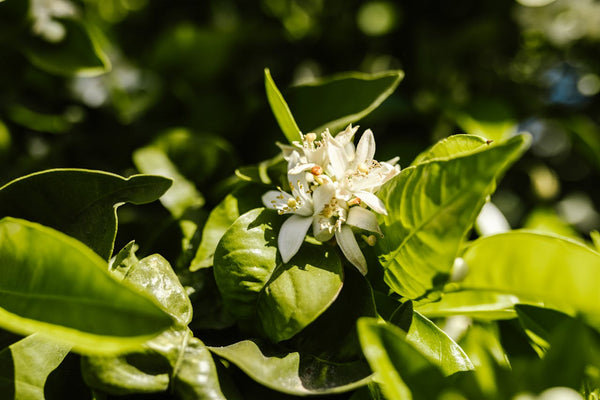
Jasmine Essential Oil- Benefits, Uses, and Origin
Jasmine flowers have been a part of many cultures for their pleasing fragrance. Jasmine essential oil is a favorite ingredient for cosmetics, soaps, and lotions. But it's charm doesn't stop there. Jasmine oil is packed with multiple health benefits for both physical and metal well-being.


The jasmine plant is a widely cultivated ornamental shrub famous for its intense floral scent. It is also grown for several medicinal purposes. There are about 200 species of the genus Jasminum where essential oils are harvested. These plants are native in tropical and temperate regions in South and South East Asia.
The name jasmine was derived from the Persian word “yasameen” which means “gift from God.”
The leaves of a jasmine plant are evergreen or lose their leaves during fall. Some varieties are shrubs while some are vines. Jasmine flowers of white, yellow, rarely pink, are harvested for the essential oil.
Jasmine's essential oil has a sweet, exotic, and rich scent is known throughout the field of perfumery. Known to be “The Queen of the Night,” jasmine’s sultry scent has been associated with sensuality and spirituality.
Jasmin oil is one of the most expensive essential oils in the world. Some of the oil’s key components are: benzyl acetate, linalool, benzyl alcohol, indole, benzyl benzoate, cis-jasmone, geraniol, and methyl anthranilate. Linalool is the component responsible for the fragrance released by the oil. This compound is an aroma molecule which also gives other oils their scent.
In the mid-19th century, Grasse became one of the largest producers of jasmine oil although it only made its way to Europe in the seventeenth century.
Sources of Jasmine Oil
Jasminum officinale/grandiflorum is regarded as the traditional jasmine. This vine can grow up to 15 feet tall and are found in countries such as India, Nepal, Europe, and China. This species of jasmine bloom during the day and it is when it is harvested. A jasmine flower is picked in the morning just as it opens for the first time. Essential oil from the traditional jasmine flower is used in perfumes because of its long-lasting fragrance.
Jasminum sambac or the Arabian jasmine is a low-growing shrub that could reach a height of up to nine feet. It originated from parts of western China and Tibet. It is an evergreen and ever-blooming plant with flowers that open up at night until early morning. Oil from the Arabian jasmine flower, although has a less sweet scent, gives the same health benefits as the traditional jasmine but it is much famous for working as a potent aphrodisiac.

 Photo by ALLEKO from iStock
Photo by ALLEKO from iStockTraditional Uses of Jasmine Essential Oil
Ancient Egyptians have used this oil to relieve headaches and encourage soothing sleep. It was used to clear and purify the hospital rooms from pollutants and bacteria in China. Aside from this, it was also used during healing and religious ceremonies, used to make teas, and treat nervous disorders. It was also regarded as an aphrodisiac and a symbol of love and fidelity. Because of the oil’s scent, it had been long associated to the feelings of sensuality, romance, and intimacy.
In different parts of the world, jasmine flower is symbolic. The flower’s oil is holy and is often worn on women’s hair for good fortune in India. In the Philippines, it is a symbol of love and fidelity while in Thailand, it represents motherhood. In Italy, jasmine flowers appeared in many religious paintings.
Benefits from Using Jasmine Essential Oil
Mood enhancer
Used in aromatherapy, jasmine oil ease symptoms of stress and depression. It boosts mental alertness by increasing the level of oxygen on the blood. This increases the activity in the nervous system when inhaled or diluted and applied on the skin. Its aroma stimulates the release of serotonin, a certain hormone in the body responsible for stabilizing the mood and gives a feeling of happiness.
Antiseptic
The antiseptic property of jasmine oil has been thoroughly studied over the years and has shown to work against certain strains of bacteria such as E. coli and certain species of candida, a type of fungi that causes yeast infection. This is because of the presence of benzaldehyde, benzoic acid, and benzyl benzoate in the oil which are proven to have antimicrobial, antifungal, and antiviral properties.
The oil helps keep wounds and cuts from getting infected. It can also relieve symptoms of cold and cough by reducing infections in the respiratory system.
Relieves cough and lessens snoring
The oil’s expectorant property helps clear out phlegm. And since it clears out the nasal and respiratory tract of congestion, it also stops the snoring.
Relief from menstrual pain and menopause symptoms
Using jasmine oil in aromatherapy relieves the symptoms of menstruation and menopause. Jasmine oil can regulate period cycles, balancing the hormones in the body. This results in a less painful period. When the menstrual cycle is regulated, menopause is pushed back.
For years, it has been used to ease the symptoms of menopause such as headaches and hot flashes. Its ability to improve the mood helps reduce depressing feelings associated with menopause. Diluting jasmine oil in carrier oil and using it as massage oil once a week can ease menopausal symptoms.

To clear and hydrate the skin
Jasmine oil has long been used to treat dry skin. It is also used to treat skin problems such as eczema, psoriasis, and dermatitis. It also helps fade scars and marks left by acne, wounds, and cuts.
Jasmine extract can also speed up the healing of chronic wounds. Applying a small amount of diluted jasmine oil on minor wounds and cuts helps heal them faster.
For childbirth and lactation
Jasmine used for aromatherapy can ease the pains associated with labor during childbirth. It promotes stronger contraction shortening the time of childbirth. It also helps women during post-natal period by speeding up the recovery process and making it less painful. And because of its antidepressant property, it helps uplift the mood of a new mom and fight off post-partum depression.
This oil also increases milk secretion, which is good for breastfeeding moms and newborns. In some parts of South India, mothers wear jasmine garland to increase lactation and delay ovulation.
Works as an aphrodisiac
Jasmine oil has aphrodisiac properties that enhance libido and sexual desires. In India, rooms of newly weds are decorated with jasmine blossoms. Sexual disorders including impotence and premature ejaculation can be treated using jasmine oil.
Inhaling jasmine increases positive and romantic feelings and energy level. A few drops on the beddings or by dabbing a little oil on the neck and wrist can help boost intimacy. Mixing patchouli oil and sweet orange oil with jasmine essential oil creates and aphrodisiac blend.
Promotes healthy sleep
Jasmine oil mixed with cedarwood oil can be used by people battling insomnia. Its sedative property works to induce long and undisturbed sleep, thus reducing stress and fatigue associated with insomnia.
Jasmine oil can be diluted in carrier oil before used as a massage oil or before applying to the skin. It can also be inhaled directly from the bottle or added to warm water to create an aromatic steam. It can also be added to warm bath water. Nowadays, it is commonly used with a diffuser.
Safety Tips and Precautions in Using Jasmine Essential Oil
Jasmine oil is safe and nonirritating. It is always recommended to dilute essential oil in carrier oil before applying it to the skin. A skin test can also be done to see if there’s a possibility of skin irritation.
It is not recommended to ingest jasmine oil. Keep it away from sensitive parts of the body such as the eyes and the insides of the nose.
Women are advised to avoid using jasmine oil during pregnancy. Although it has a positive effect on lactating women, it is best to seek a recommendation from a physician.
